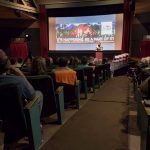
Fire Safe Council presents CWPP to public
About one month after the Manzanita Fire, which started near Lambs Canyon and burned east towards Poppet Flat, and during the Rose Fire in western Riverside County, few residents attended the meeting to discuss the local fire prevention plan. But those who did learned a lot about the current plans and work of the various fire agencies on the Hill.
The Mountain Communities Fire Safe Council, with the collaboration of all of the local fire agencies, is revising the Community Wildfire Protection Plan. Monday night, the MCFSC, with the agencies, presented it to the public.
“The questions were good, the discussion interesting, but wish more people had come,” said Norm Walker, MCFSC president. “This is the last opportunity for the public involvement in the Mountain CWPP.”
After an introduction from Walker, Edwina Scott, MCFSC executive director, discussed the purpose and importance of the plan.
The 2003 Healthy Forests Restoration Act authorized communities to prepare a Wildfire Protection Plan. Its purpose would be to guide funding agencies to support the most important fire protection projects and ensure that the public was involved, and not leave it to the exclusive decision of fire agencies.
MCFSC, with the U.S. Forest Service, Cal Fire, Idyllwild Fire Department, the Bureau of Land Management, State Parks and Esri, prepared the original Hill CWPP in 2006. It was updated in 2010.
At the meeting, Walker said the intention is to revise the plan every two years, which drew applause from the audience.
“Updating the plan makes it more dynamic,” said Idyllwild Fire Chief Patrick Reitz. “The 10-year projects are ready to be refreshed.”
Scott emphasized that one of the original intentions for the creation of the CWPPs was to ensure collaboration between communities and fire agencies. However, that has always been a strength among Hill fire agencies. Since the 1990s, preceding the Mountain Area Safety Taskforce, they have held regular joint meetings to discuss and plan firefighting and deal with other forest problems, such as the bark beetle or oak borer.
“Our fire agencies on the mountain are known for their collaboration,” Scott said. With the history of fire on the mountain, four — Esperanza, Silver, Mountain and Manzanita — since the original CWPP, Scott acknowledged that any fire project here would benefit the whole mountain area.
Walker asked people who feel more funds — federal or state — were needed for the fuels projects to please write their local elected representatives. Agency staff is not permitted to lobby for funding of any sort, so it often depends on public involvement to ensure that money flows to these projects, he noted.
Representatives from each agency described the past work and future projects. And the group took time to study the maps of the projects.
After reconvening, a question-and-answer session was held. No comments or modification to projects were offered. Walker did say he would talk to Chief Greg Bratcher, Riverside County Fire at the Mountain Resource Center, about ensuring the agencies meet more frequently to be sure projects are coordinated.
The plan will be completed this month and signatures from the agencies and the Riverside County Board of Supervisors will be obtained to finish it, Scott said.
“I can make my house as safe as possible,” said one person. “But I’m only as safe as my neighbor makes their property.” Scott agreed that on the Hill we rely on each other.










